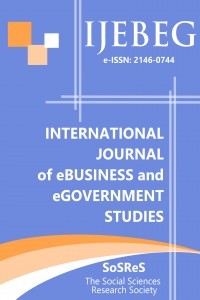ORGANIZATIONAL READINESS, ENTREPRENEURSHIP, EXTERNAL PRESSURES & STRATEGIC VALUE OF E-COMMERCE ADOPTION: PERCEPTIONS OF CEOS OF BRUNEIAN SMES
ORGANIZATIONAL READINESS, ENTREPRENEURSHIP, EXTERNAL PRESSURES & STRATEGIC VALUE OF E-COMMERCE ADOPTION: PERCEPTIONS OF CEOS OF BRUNEIAN SMES
The present study investigates 85 owners cum CEOs of the Bruneian SMEs regarding their perception of organizational readiness, entrepreneurial orientation, and external pressures towards perceived strategic value that further lead to the electronic commerce (EC). PLS-graph was used to test the model. Among the three contextual variables such as entrepreneurial orientation of the CEOs, organizational readiness and external factors only organizational readiness is significant to perceived strategic value of EC that in turn predict the organizational adoption of e-commerce. Based upon the results and conclusions some recommendations are made for the relevant authorities to gear up the EC adoption
___
- Amit, R., and Zott, C. (2001).“Value Creation in E-business”.Strategic Management Journal, 22, 493-520.
- Barua, A., Kriebel, C. H., Mukhopadhyay, T. (1995). “Information Technology and Business Value: An Analysis and Empirical Investigation”. Information Systems Research, 6(1), 3-22.
- Brown, I. T. J. (2002). “Individual and Technological Factors Affecting Perceived Ease of Use of Web-based Learning Technologies in Developing Countries”. EJISDC, 9(5), 1-15.
- Byrd, T. A., and Turner, D. A. (2001). “An Exploratory Examination of the Relationship between Flexible IT Infrastructure and Competitive Advantage”. Information and Management, 39, 41-52.
- Cheung, W., Chang, M. K., Lai, V. S. (2000). “Prediction of Internet and World Wide Web Usage at Work: A Test of an Extended Triandis Model”. Decision Support Systems, 30, 83-100.
- Choi, S. Y., et al. (1991). The Economic of Electronic Commerce. [Indianapolis, IN: Macmillan Technical Publications].
- Davis, F.D. (1989), “Perceived Usefulness, Perceived Ease of Use and User Acceptance of Information Technology”, MIS Quarterly,13, 319-340.
- Fichman, R. G. (2004). "Going beyond the Dominant Paradigm for Information Technology Innovation Research: Emerging Concepts and Methods”, Journal of the AIS, Vol. 5, Issue 8, pp.1-30.
- Fishbein, M., and Ajzen, I. (1975).Attitude, Intentions and Behavior: An Introduction to Theory and Research. [Reading, MA: Addison-Wesley]
- Grandon, E., and Pearson, J. M. (2003), “Strategic Value and Adoption of Electronic Commerce: An Empirical Study of Chilean Small and Medium Businesses”, Journal of Global Information Technology Management, 6(3), 22-43.
- Grandon, E., and Pearson, J. M. (2004), “Electronic Commerce Adoption: An Empirical Study of Small and Medium US Businesses”, Information and Management, 42, 197-216.
- Han, S. (2003). “Individual Adoption of IS in Organizations: A Literature Review of the Intention-Based Theories”, [Turku, Finland: Turku Center for Computer Science]
- Hitt, L. M., and Brynjolfsson, E. (1996). “Productivity, Business Profitability, and Consumer Surplus: Three Different Measures of Information Technology Value”, MIS Quarterly, June, 121-142.
- Hong, W. and Zhu, K. (2005) “Migrating to Internet-based E-Commerce: Factors Affecting E-Commerce Adoption and Migration in the Firm Level”, Information & Management.
- Mehrtens, J., Cragg, P. B., Mills, A. M. (2001). “A Model of Internet Adoption by SMEs”.Information and Management, 39, 165-176.
- Molla, A., and Licker, P. S. (2005). “e-Commerce Adoption in Developing Countries: A Model and Instrument”. Information and Management, 42, 877-899.
- Pham, L., Pham, L. N., and Nguyen, D. T. T. (2007) ‘Determinants of E-Commerce Adoption in Vietnamese SMEs”, [www.sept.uni-lepzig.dc]
- Seyal, A.H., Rahman, M. N. (2003). “A Preliminary Investigation of E-Commerce Adoption in Small and Medium Enterprises in Brunei”.Journal of Global Information Technology Management, 6(2), 6-26.
- Seyal, A.H. and Rahman, M.N. (2007). “The Influence of External Variables on the Executives’ use of the Internet”. Business Process Management Journal, 13(2), 263-277.
- Seyal, A. H., and Rahim, MD. (2010) “Understanding E-Commerce Adoption in Bruneian SMEs: A Replication of the Application of TAM and Perceived Strategic Value Models”, Journal of Electronic Commerce in Organizations (JECO), Vol. 8(4), 32-50.
- Sutanonpaiboon, J., and Pearson, A. M. (2006) “E-Commerce Adoption: Perceptions of Managers/Owners of Small-and Medium-sized Enterprises (SMEs) in Thailand”, Journal of Internet Commerce, Vol. 5(3), 53-82.
- Subramanian, G. H. (1998). “A Replication of Perceived Usefulness and Perceived Ease of Use Measurement”.Decision Sciences, 25, 863-874.
- Subramanian, G.H., and Nosek, J. T. (2001). “An Empirical Study of the Measurement and Instrument Validation of Perceived Strategic Value of Information Systems”, Journal of Computer Information Systems, Spring, 64-69.
- Taylor, S., and Todd, P. (1995).“Assessing IT Usage: The Role of Prior Experience”.MIS Quarterly, 19(4), 561-570.
- Başlangıç: 2009
- Yayıncı: Sosyal Bilimler Araştırmaları Derneği
Sayıdaki Diğer Makaleler
REFLECTION AND REFRACTION FOR KNOWLEDGE MANAGEMENT SYSTEMS
Tunc D. Medeni, I. Tolga Medeni
Yakub Gedikoglu, Tunc Durmus Medeni
ASSESSING E-GOVERNMENT SERVICE DELIVERY (GOVERNMENT TO CITIZEN)
Syed Faizan Hussain Zaidi, Mazen K. Qteishat
A COMPARATIVE STRATEGIC ANALYSIS OF SPACE TECHNOLOGIES: DEVELOPING A ROADMAP FOR TURKEY
GOVERNMENTAL MOBILE TECHNOLOGY USAGES DURING PROMOTION EFFORTS OF REACHING THEIR CITIZENS
Fazli Yildirim, Ugur Cevdet Panayirci
INCORPORATE SOCIAL NETWORK SERVICES IN E-GOVERNMENT SOLUTIONS. THE CASE OF MACEDONIA
Koste Budinoski, Vladimir Trajkovik
COMPETITIVENESS OF E-COMMERCE COMPANIES: AN INTEGRATED APPROACH
